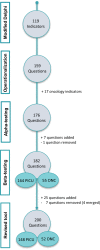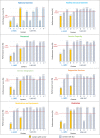Development and pilot testing of PROACTIVE: A pediatric onco-critical care capacity and quality assessment tool for resource-limited settings
- PMID: 36324249
- PMCID: PMC10028058
- DOI: 10.1002/cam4.5395
Development and pilot testing of PROACTIVE: A pediatric onco-critical care capacity and quality assessment tool for resource-limited settings
Abstract
Background: Nearly 90% children with cancer reside in low- and middle-income countries, which face multiple challenges delivering high-quality pediatric onco-critical care (POCC). We recently identified POCC quality and capacity indicators for PROACTIVE (PediatRic Oncology cApaCity assessment Tool for IntensiVe carE), a tool that evaluates strengths and limitations in POCC services. This study describes pilot testing of PROACTIVE, development of center-specific reports, and identification of common POCC challenges.
Methods: The original 119 consensus-derived PROACTIVE indicators were converted into 182 questions divided between 2 electronic surveys for intensivists and oncologists managing critically ill pediatric cancer patients. Alpha-testing was conducted to confirm face-validity with four pediatric intensivists. Eleven centers representing diverse geographic regions, income levels, and POCC services conducted beta-testing to evaluate usability, feasibility, and applicability of PROACTIVE. Centers' responses were scored and indicators with mean scores ≤75% in availability/performance were classified as common POCC challenges.
Results: Alpha-testing ensured face-validity and beta-testing demonstrated feasibility and usability of PROACTIVE (October 2020-June 2021). Twenty-two surveys (response rate 99.4%) were used to develop center-specific reports. Adjustments to PROACTIVE were made based on focus group feedback and surveys, resulting in 200 questions. Aggregated data across centers identified common POCC challenges: (1) lack of pediatric intensivists, (2) absence of abstinence and withdrawal symptoms monitoring, (3) shortage of supportive care resources, and (4) limited POCC training for physicians and nurses.
Conclusions: PROACTIVE is a feasible and contextually appropriate tool to help clinicians and organizations identify challenges in POCC services across a wide range of resource-levels. Widespread use of PROACTIVE can help prioritize and develop tailored interventions to strengthen POCC services and outcomes globally.
Keywords: critical care medicine; global health; health quality of care; pediatric cancer; quality improvement.
© 2022 The Authors. Cancer Medicine published by John Wiley & Sons Ltd.
Conflict of interest statement
The authors have no conflict of interest to disclose.
Figures



References
Publication types
MeSH terms
LinkOut - more resources
Full Text Sources
Medical

